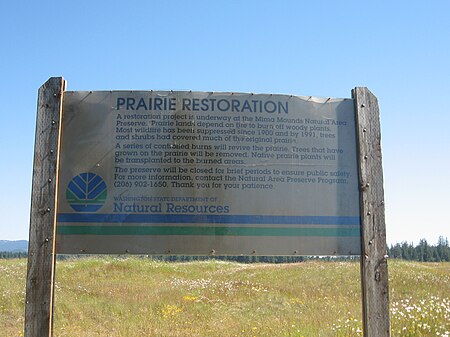Mima Mounds Natural Area Preserve
1976 establishments in Washington (state)IUCN Category IIILandforms of Thurston County, WashingtonNational Natural Landmarks in Washington (state)Protected areas established in 1976 ... and 3 more
Protected areas of Thurston County, WashingtonUse mdy dates from May 2023Washington Natural Areas Program

Mima Mounds Natural Area Preserve is a state-protected Natural Area in southwest Washington state, United States. The preserve includes some of the Washington mima mounds, the origin of which still is not fully understood. The site comprises 637 acres (258 ha) of Garry oak woodland, oak savanna, and prairie grasslands. Several state and federal endangered species of butterfly depending on the unique prairie conditions can be found in the preserve, including Mardon skipper, zerene fritillary, Puget blue and Taylor's checkerspot.In 1966, the mima mounds were designated a National Natural Landmark.
Excerpt from the Wikipedia article Mima Mounds Natural Area Preserve (License: CC BY-SA 3.0, Authors, Images).Mima Mounds Natural Area Preserve
Mima Mounds South Loop Trail,
Geographical coordinates (GPS) Address Nearby Places Show on map
Geographical coordinates (GPS)
| Latitude | Longitude |
|---|---|
| N 46.89 ° | E -123.05 ° |
Address
Mima Mounds South Loop Trail
Mima Mounds South Loop Trail
98556
Washington, United States
Open on Google Maps

